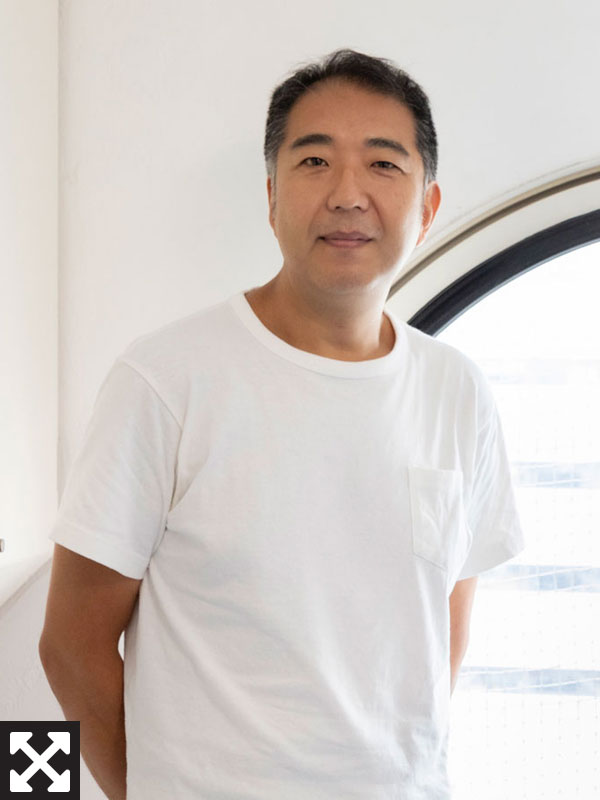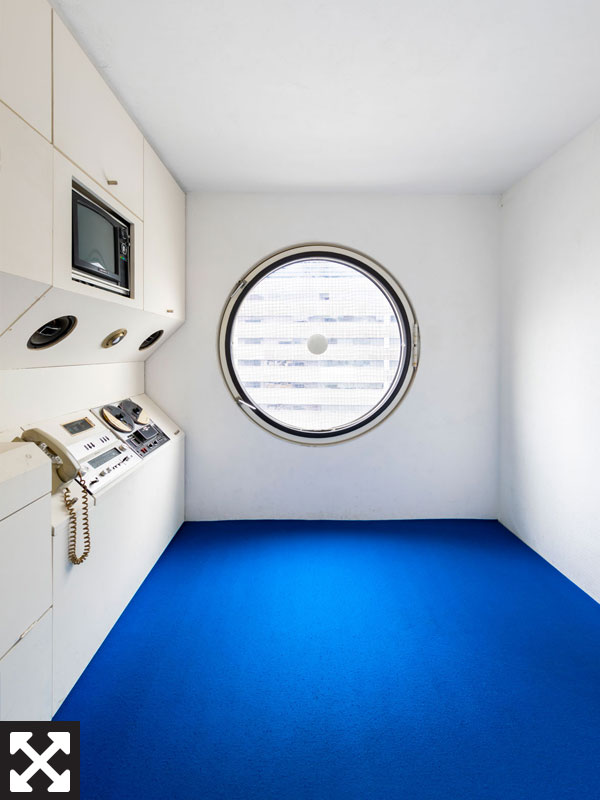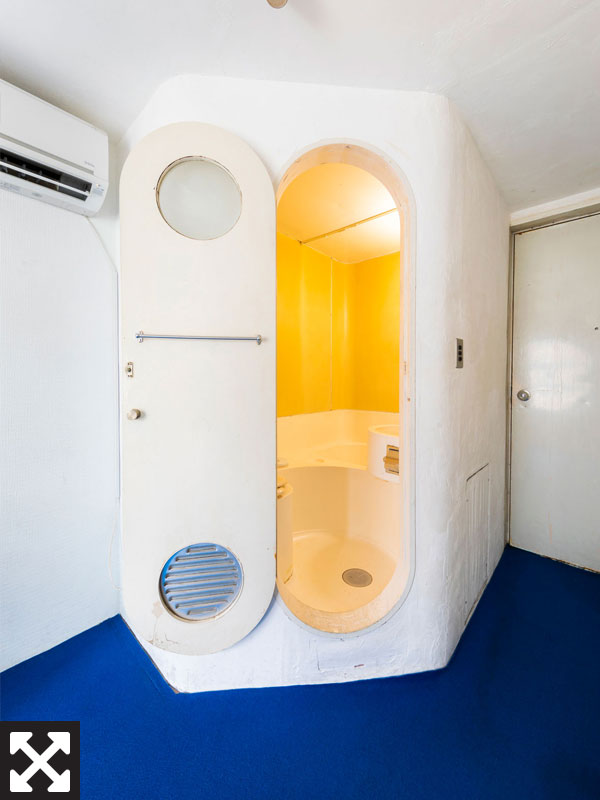LIFE
Nakagin Capsule Tower
Saving an urban dream from the ravages of timeThe future of Tokyo’s Nakagin Capsule Tower hangs in the balance as architectural enthusiasts attempt to preserve the fading landmark
CHRIS RUSSELL
Staff writer
In the 1970s, if you were to take a walk through a certain part of Tokyo’s upscale Ginza district, one building in particular would have almost certainly caught your eye. Eschewing anything resembling traditional design, the zig-zagging geometry of its array of small, gleaming pods cutting against the azure sky, the Nakagin Capsule Tower was, and remains, a striking sight.
While the building exuded a technology-fueled optimism at the time of its construction in 1972, the structure, designed by renowned architect Kisho Kurokawa (1934-2007), gives off a different impression today, with the building seemingly hemmed in by the towering glass-and-steel structures that now surround it and a large net almost forlornly cast over the building ever since one of its windows fell onto the street below — not so much a future that awaits but a future lost.
Unsurprisingly, its unique, forward-looking design has seen the building become a minor pop cultural fixture, featuring in numerous music videos as well as films such as “The Wolverine” starring Hugh Jackman — in the latter case as a love hotel in Hiroshima Prefecture, naturally.
Although the Nakagin Capsule Tower is still capable of lending such productions a futuristic sheen, its reality is one of neglect and decay. The threat of demolition has long hung over the building even as a committed group of residents and architectural enthusiasts have fought to save it, with their battle now entering a crucial stage.
Today, the capsules have long lost their luster and are rusting on the outside, the structure’s earthquake resistance is deficient, there are problems with hot water, drainage, leaks and the air conditioning, and the building is full of asbestos.
“To solve (the problems), basically the only solution left is to exchange the capsules,” says Tatsuyuki Maeda, head of the project to preserve the building.
Forty capsules have fallen into such an extreme state of disrepair that they are now unusable, with some having been used to grow plants — an echo of metabolism, the name of the architectural movement underpinning the tower, of which Kurokawa was a key figure. Another 80 are used as offices, second homes or hobby rooms — the capsules’ soundproofing lends them to practicing musical instruments — and 20 people actually live there.
Maeda himself owns 15 of the capsules, with his first purchase coming in 2011, and he sits on the building’s management board. Initially passing the tower on journeys to school and, later, working nearby, in many ways his involvement in the Nakagin project is the culmination of a lifelong interest.
Currently, the preservation project is in talks with a foreign company — Maeda is unable to say who — that attempts to conserve old buildings and neighborhoods and is interested in buying Nakagin. The current owner of the land seeks to redevelop the complex, and, if a purchase is unsuccessful, demolition is a likely outcome.
The foreign company also supports the replacement of the capsules, which, including additional renovation work, a construction company has estimated could cost at least ¥2 billion, excluding the price of land. A more detailed estimate of the total cost, which will be used to formulate a bid, is currently being drawn up, with a final offer expected to be reached by February, although it could take longer.
“If possible, they are considering paving the path toward (registering the towers as) a World Heritage site, or as a Tangible Cultural Property,” says Maeda, adding that the International Council on Monuments and Sites has already come to inspect the building.
That the building is still around to be considered for such a distinction is a small miracle in itself. In 2007, support for demolition by capsule owners passed the crucial 80 percent threshold, but the Nakagin Capsule Tower found an unlikely savior — the global financial crisis. With the resulting hit to the economy, Nakagin Group couldn’t proceed with its plans for redevelopment.
“Fortunately, they stopped the development and demolition,” says Kenji Watanabe, chair of the Japan chapter of Docomomo, an international organization dedicated to researching and conserving modern architecture. “That’s why it’s still there.”
The interior of a living space in Nakagin Capsule Tower in Tokyo’s Ginza district. MARTIN HOLTKAMP
Metabolist memories
Between the cost and litany of problems facing the tower, you might reasonably ask what the point of saving it is. But the ideas that lie behind Nakagin give the building vast historical and architectural importance, with metabolism being Japan’s first postwar architectural movement of international significance.
Responding to both the devastation of Japan during World War II and the socioeconomic transformations that followed it, metabolism posited an idea of urbanism that saw cities and buildings as evolving and developing in the manner of living organisms — a radical challenge to existing ideas of city planning, with the metabolists prioritizing process over grand, fixed visions for the urban environment. A sense of the significance of the movement is given by the fact that three architects associated with metabolism have won the Pritzker prize.
“This metabolist movement presented the idealism of architecture in the 1960s: Many goals they set for the movement or for architecture or for city design remain the high kinds of ideals of many architects,” says Zhongjie Lin, an associate professor at the University of Pennsylvania’s Weitzman School of Design and author of “Kenzo Tange and the Metabolist Movement: Urban Utopias of Modern Japan.”
Much of the work of the metabolists, however, remained theoretical, with few built examples in existence — other notable buildings include Tange’s Yamanashi Press and Broadcasting Center — further increasing Nakagin Capsule Tower’s importance.
In particular, the ideas behind the tower of modularity, industrialization and an embrace of recyclability and compact living still resonate today, says Lin, who points to ongoing attempts to build prefabricated towers and the existence of the small, yet adaptable Muji Hut as examples of Nakagin’s enduring relevance.
“Nakagin Capsule Tower represents the dream of a new type of urban living and a completely new urban form,” Lin says.
Metabolism itself tended to overreach, however, with many ideas not being supported by the technology of the time. Although Nakagin’s capsules were envisaged as being replaceable, with owners changing and upgrading their capsule, or even moving it to a completely different location, as they wished, the building design doesn’t quite allow for such a free-wheeling approach to city living — capsules were installed from the bottom up, meaning that moving one requires all of those above it, too. The planned modularity of Tange’s Shizuoka Press and Broadcasting Center, also located in Ginza, has similarly gone unrealized.
And at the time of its construction, Nakagin Capsule Tower was pitched toward a more prosaic demographic — salarymen used to working long into the night and in need of a centrally located space in which to live and work. Pitching the building to those staying in the office until 2 a.m. now seems slightly jarring in a world of high-profile incidents of karōshi (death by overwork), but Maeda insists the ideas behind the tower were ahead of their time and today’s lifestyles have finally caught up, citing trends toward minimalist living, nomadic lifestyles and the embrace of koya (cabins) as living spaces.
The original brochure for the Nakagin Capsule Tower, targeting businessmen. ANDREW LEE
Design legacy
For all its impact and audacity, Japan’s hardly stellar record of preserving modern architecture casts a shadow over the project to save Nakagin. Of the 226 buildings so far listed as worthy of preservation by Docomomo Japan, 21 have been demolished. And although a facsimile of the original design was recently built, the demolition of the Hotel Okura’s iconic Yoshiro Taniguchi-designed lobby in 2015 drew an international outcry and highlighted for many how the country’s postwar architectural legacy isn’t always respected.
“The preservation of modern architecture is basically a failure,” Maeda says. “Japan is inevitably trapped in a scrap-and-build culture.”
Talk of preserving Nakagin reaches back to the mid-1990s, when British architect and writer Dennis Sharp, who organized an exhibition on Kurokawa’s work in London around that time, proposed gathering information on registering the tower as a cultural asset.
However, there is a question of how well conservation sits with metabolist ideas of growth and change. World Heritage rules, for example, stress how a building’s “conditions of integrity and/or authenticity at the time of inscription” should be sustained or enhanced, and it is unclear how UNESCO would interpret that in the context of a building designed to evolve like the Nakagin Capsule Tower.
“If the tower is demolished, it would actually be a testament to the theory of metabolism — that the city is ever-changing,” Lin says with a laugh. “But a building is also an artifact. And as an artifact, it actually also embodies human culture, human ideals that we have.”
Kurokawa himself expressed his desire to see the capsules replaced, saying, “if you replace the capsules every 25 years, the building could be recycled for up to 200 years.”
“I designed the building to be an example of sustainable architecture, and it was the first of its kind in the world,” he told Tokyo Art Beat in a 2007 interview published a few months before his death. “I designed the building to have its capsules replaced every 25 years, so it’s ridiculous that 25 years have gone by and nothing has been done.”
Watanabe of Docomomo Japan, meanwhile, stresses the notion of “living heritage” — the idea being that while the facade and underlying philosophy of the architect should be respected, other aspects of the building are much more adaptable.
“Changing the function, changing the material is OK … but please don’t change the important characteristics, the design of the original design, the idea of the architect,” Watanabe says.
Maeda’s own ideas regarding the tower’s possible function post-renovation seem to go along with that, and he foresees the tower becoming less residential and more open to the public, although not completely so, with an emphasis on the curation of art and technology. In a sense, this is an extension of what Nakagin is currently used for, with the capsules being used by hobbyists and hosting TV and photography shoots, a direction Maeda has encouraged. Existing residents tend to work in art-related fields, too.
The Nakagin Capsule Tower’s futuristic appearance often features in movies and music videos. ANDREW LEE
Looming in the background in the preservation debate is the potential role of government. Over the years, Japan has been very proactive in securing World Heritage listings, for example, but these have tended to be for sites of natural beauty or those linked to traditional culture. Where it has embraced buildings outside those areas, they have primarily focused on those associated with the process of modernization seen during the Meiji Era (1868-1912) — although Japan did throw its weight behind a transnational effort to list work by the pioneer of modern architecture Le Corbusier, which included the National Museum of Western Art in Tokyo.
Last year, the preservation project launched a petition addressed to Tokyo Gov. Yuriko Koike appealing for help in replacing the capsules, attracting just under 8,500 signatures in the process. The petition was subsequently bounced between various departments of the Tokyo Metropolitan Government before, ultimately, it was decided that nothing could be done, as it is not public property.
While Maeda says that the government should intervene in preservation, there is a sense among others that efforts to conserve the tower would be better done through engaging surrounding communities and raising awareness. Watanabe stresses the need to increase appreciation of the value of modern architecture in Japan, arguing that the subject should be taught in schools. Exhibitions can play a role, too, with a metabolism retrospective at the Mori Art Museum in 2011 being a notable example.
Yuka Yoshida, co-founder of Showcase Tokyo, which holds English-language tours of Nakagin, notes how little awareness there is of the building among Japanese people. “I hear a lot of people saying that they asked the way to this building, but none of the people walking around knew about this building, or whether this existed or not,” Yoshida says. “So it’s really amazing — Japanese people don’t know about this building.”
For her part, Yoshida thinks open house events, as seen in other cities, could drive greater appreciation. Still, that can take different forms, with implications for how conservation should be carried out.
“It’s two different kinds of appreciation: It’s appreciation of the building as preserving the history of the past and the appreciation of the building as part of the urban fabric. And right now I think the problem that the Nakagin Capsule Tower encounters is that these two cannot be reconciled,” says Lin, who nonetheless speaks approvingly of Maeda’s intentions for the tower.
“It would be kind of a breakthrough in design and preservation if this can be accomplished,” he says of the plan.
While a path forward for the building has emerged, whether it can take it remains an open question for the time being. What is more certain is the strength of feeling that the Nakagin Capsule Tower elicits.
“The thing that I really feel about doing the tour is that people really have an interest and really have love toward this building, the idea and the theory,” Yoshida says. “A lot of people want to preserve this building, but it doesn’t mean just preserving as it is.
“Everyone really wants to see it metabolize at some point.”






